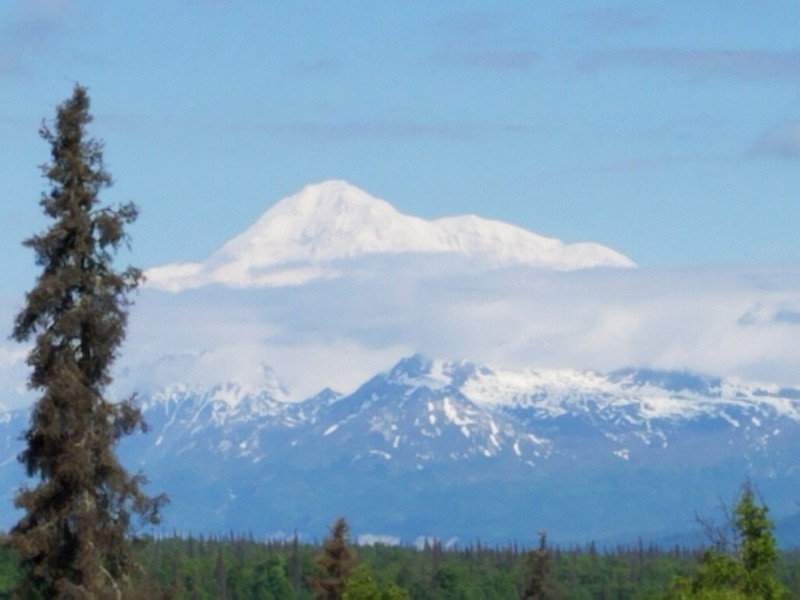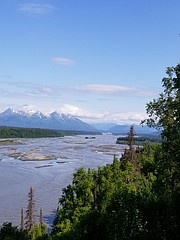There are not enough superlatives to describe Alaska. Sixteen Chattanoogans of all ages visited the 49th state this summer, and for two weeks traveling in four rental RVs over 1,500 miles, we were overwhelmed with this big, beautiful and bold land.
If you go to Alaska and really want to experience it, don't expect to do it in a single trip, perhaps not in a single lifetime. Why? Simply because it is too big. Alaska encompasses 663,267 square miles. Compare that to Texas, the largest of the lower 48 states at 268,581. If Alaska were a separate country, it would be the 17th largest in the world.
However, the vastness of the land is only one component of Alaska's bigness. The diversity of its land makes it even larger. There are 27,000 uninhabitable and impassable glaciers. Additionally, two of the highest mountains in North America are in Alaska: Denali at 20,310 feet and St. Elias at 18,009 feet. Associated with those peaks are volcanoes and a multitude of impassable ranges. Finally, there are thousands of miles of coastline along the mainland as well as the Aleutian Islands, stretching into the Pacific to the southwest and the Alaska Panhandle, sandwiched between Canada and the Gulf of Alaska to the southeast.
We spent our time during this trip in the interior of Alaska. We flew into Anchorage, where we picked up our RVs, then made a 1,500-mile loop to Denali National Park, Fairbanks, Valdez and back to Anchorage.
DENALI
Mount Denali (formerly Mount McKinley) sits in the center of Denali National Park, the third largest national park in the United States, and contains more than 4 million acres of wilderness. Over 600,000 people visit the park annually. The only entrance is on the eastern boundary and access is via a single, gravel road that goes only 92 miles into the park, less than halfway to the western boundary. At various times, the park service considered extending and paving the road and offering more amenities. They decided against it. Such decisions to limit or expand the human footprint were delicately balanced between progress and responsible preservation of the land as God created it.
U.S. Forest Service writer and researcher Bob Marshall, an avid outdoorsman and explorer of Alaska's interior, once said it best, "There is just one hope of repulsing the tyrannical ambition of civilization to conquer every niche on the whole Earth. That hope is the organization of spirited people who will fight for the freedom of the wilderness." In Alaska, more than anywhere on Earth, people are striving to reach that fragile balance between civilization and wilderness.
There are six campgrounds within the park, but only three for RV camping, so early reservations are critical. We stayed in Teklanika River campground, the RV park deepest within the park. It is "rough camping," which means no water or electrical hook-ups. Park buses provide transportation and run every 20-25 minutes. It was wonderful.
One day, a large grizzly and her two cubs appeared on the edge of the campground, and she promptly killed a caribou and a moose for supper. The rangers were alerted and cordoned off the area for everyone's safety. We realized quickly we were no longer No. 1 on the food chain! The rangers also made this point each evening during their presentations.
For most visitors, activity is limited to the park road, but for the adventurous, day and overnight hikes and camping opportunities are plentiful and encouraged. The view from the buses, however, wasn't bad. We saw moose, caribou, grizzlies, Dahl sheep, Arctic hares (not rabbits), wolves, bald eagles and the large and rare gyrfalcon, along with spectacular beauty in every direction. Polychrome Pass (5,800 feet above sea level), for instance, is a winding narrow road with no guardrails and terrain falling away from the road almost straight down to a river 4,000feet below. Our driver told us dryly that they've never lost a park service bus - they always find them down by the river!
Of course, the ultimate outdoor adventure is climbing Mount Denali itself, a three-week ordeal. The price per person in a group with six climbers and three guides is $10,500 and begins at the base camp at about 7,000 feet elevation. Climbers must be experienced and in top condition. On average, 1,275 climbers begin the trek annually, but only half reach the summit. The park service expects 14 rescues on the mountain and one fatality each year.
FAIRBANKS
We left the indescribable beauty of Denali for the interior city of Fairbanks, another 125 miles north. The drive itself was incredible, with stunning vistas over each hill and around each curve. Fairbanks came of age during the Alaska Gold Rush in the early 1900s when gold prospectors and pioneers like those Jack London described in his epic "Call of the Wild" risked everything to search for gold. Today the metro area includes nearly 100,000 residents and has all the conveniences of a modern city. Large U.S. military bases at Fort Wainwright and Eielson Air Force Base contribute significantly to the economy. There are even electrical outlets in public parking areas to keep the oil in engines heated during the brutally cold winters.
Fairbanks caters to tourists. Some of the attractions are cheesy, and some are fun and informative, like riding the paddlewheel boat Discovery on the Chena River or visiting Gold Dredge 8, which explains the Gold Rush and present-day gold mining in Alaska. Part of our group made the 200-mile drive from Fairbanks to the Arctic Circle. The rough road is open all year, even when it is 50 degrees below zero.
VALDEZ
From Fairbanks we drove 500 miles south on the Richardson Highway to Valdez. Most Alaska highways are numbered, like other states', but the locals prefer to honor the men who engineered and oversaw their construction - Parks, Richardson, Dalton, Glenn and others. Given the temperature extremes, steep passes, high bridges, massive culverts and retaining walls and deep ditches and basins to manage water runoff, the engineers needed bold creativity.
The Richardson Highway crosses the Alaska and the Chugach mountain ranges and offers spectacular views of massive glaciers, plummeting waterfalls and soaring mountain peaks. There are few towns, stores, restaurants and gas stations along the way, so the trip requires planning. The most-sought-after planning aid is The Milepost, a detailed mile-by-mile explanation of points of interest along Alaska's highways.
Valdez is a quaint fishing village clinging to the rocky shoreline of Prince William Sound. It is the northernmost Alaska port facility that doesn't freeze during the winter; consequently, it is the terminus for the Alaska Pipeline. The pipeline travels over 800 miles from Prudhoe Bay in northern Alaska to Valdez, where oil is loaded onto tankers and transported to refineries in the lower 48.
Today, only 500,000 barrels of oil flow through the pipeline daily, but at peak production in the 1990s it was over 2 million. It is truly a bold feat of engineering, given the environmental concerns, extreme cold, frequent earthquakes and potential terrorist attacks. However, the oil companies have done an outstanding job, and for over 40 years there hasn't been a problem. Caribou herds traditionally graze near the pipeline in certain areas, and their numbers have even increased since the pipeline was built.
Unfortunately, the human factor came into play when the Exxon Valdez ran aground and spilled 10.8 million gallons of crude oil into the pristine waters of Prince William sound in March 1989. Many problems were identified, and billions of dollars were spent both to clean up the spill and to improve safety. We booked an all-day excursion on the Valdez-based yacht Lulu Belle to view Columbia Glacier and saw a plethora of sea otters, sea lions, waterfowl, bald eagles and whales once again populating this beautiful sanctuary.
This article barely scratches the surface of this big, bold, beautiful land. It is a phenomenal place to visit, but don't expect to do it in a single trip. It will only inspire you to return again ... and again ... and again.
Roger Smith, a local author, is a frequent contributor to the Times Free Press. Email him at capt.737@hotmail.com.

